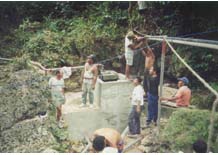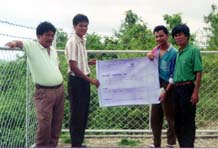
The Philippine-German Photovoltaic Pumping
Project is part of of a worldwide research and development program carried out in seven
countries, one of which is the Philippines. The program involves close cooperation with
national and local water and energy authorities, universities and manufacturers of photovoltaic pumping equipment.
Photovoltaic pumping (PVP) is an attractive solution for pumping water in unelectrified
areas. PVP Systems utilize the energy of the solar radiation to pump water from a well, a
spring or any other source to an elevated reservoir from where the water will be
distributed to the consumers. The solar generator converts the sunlight directly into
electricity by means of the photovoltaic effect. The direct current (DC) generated by the
solar panels can directly drive the DC-motorpump. The solar panels, with no moving parts,
are environmentally harmless and can easily last for more than twenty years, providing
substantial savings on fossil fuels and other operation costs. This proves the technical
and economical viability and social acceptance of solar pumping system in tropical
developing countries such as the Philippines. universities and manufacturers of photovoltaic pumping equipment.
Photovoltaic pumping (PVP) is an attractive solution for pumping water in unelectrified
areas. PVP Systems utilize the energy of the solar radiation to pump water from a well, a
spring or any other source to an elevated reservoir from where the water will be
distributed to the consumers. The solar generator converts the sunlight directly into
electricity by means of the photovoltaic effect. The direct current (DC) generated by the
solar panels can directly drive the DC-motorpump. The solar panels, with no moving parts,
are environmentally harmless and can easily last for more than twenty years, providing
substantial savings on fossil fuels and other operation costs. This proves the technical
and economical viability and social acceptance of solar pumping system in tropical
developing countries such as the Philippines.
The Philippine counterpart agencies were
the Department of Energy, the Provincial Government units (PPDO and PEO), the Local Water
Utilities Administration, and the Water Resources Center of the University of San Carlos
as the implementing institution. The implementation of the project involved the
installation of photovoltaic pumping system and the pipelaying of distribution pipes. Most
importantly, it entails the formation of a community association who would eventually
manage the entire water system.
By March 1993, the first five PVP Systems
were installed in the province of Cebu, one of which was in Bagtik, San Remegio which
holds the world record in solar pumping system with the highest pumping head of 125
meters.
The PVP Project in Bagtik, San Remegio
aimed to give the 383 households in the three barangays (Barangays Bagtik and San Miguel
of San Remegio, and Barangay Kantubaon of Tabuelan) access to clean, safe and potable
water. The project was participatory in nature. The beneficiary residents in Barangays
Bagtik, San Miguel and Kantubaon provided counterpart labor such as construction work,
hauling of materials, pipelaying, and the formation and training of Rural Water and
Sanitation Association (RWSA) for the operation and maintenance of the water system.
After the completion of the project, the
management of the water  system was turned over to the association. The Bagtik RWSA is now
charging water fees which are lower than what the beneficiaries used to pay for their
water supply. The collected fees remain as the capital income of the association which
they used for operation and maintenance expenses, and for the eventual upgrading of
components at the end of its sevice life, ensuring a sustained water system for many years
to come. system was turned over to the association. The Bagtik RWSA is now
charging water fees which are lower than what the beneficiaries used to pay for their
water supply. The collected fees remain as the capital income of the association which
they used for operation and maintenance expenses, and for the eventual upgrading of
components at the end of its sevice life, ensuring a sustained water system for many years
to come.
The Bagtik RWSA has effectively and
efficiently managed the water system. Almost a decade after, the association was able to
expand their service and membership to three more barangays of Tabuelan, proving the
viability of a community-managed water system.
The formation of RWSA has been replicated
by WRC in different areas of Cebu, such as IlanTagan Island at Daanbantayan, Tabla at
Liloan, Kawasan and Sacsac at Aluginsan, Nangka at Boljoon, Kawit at Pilar; at Limasawa
Island; and at Sablayan, Mindoro Occidental. WRC has developed a Field Manual on Formation
of Rural Waterworks and Sanitation Association for water project implementors of the local
government units and the community organizers of non-government organizations who are
involved in the social preparation of local communities. The Manual, which is available by
request, is a product of studies accumulated off-the-field and on-field experiences in
years of implementing water projects.
basic info
| initiative
| strategy
| critical factors
| other links
| home
|

